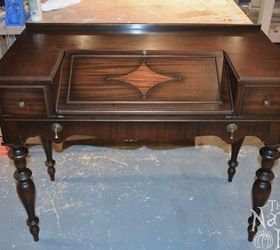Using exotic wood veneer and chalk paint, I turn a vintage yawner of a desk into a sleek stunner in black, blond and brown.My wife and I found this desk made by Grand Rapids Chair Co. at an antique shop this past summer. It was more than we usually like to pay (free or a few dollars), but it had great potential. The veneer was peeling and it was pretty scratched up. My plan was to remove all the old veneer from the desktop, the drawer faces and the sides, then re-veneer the top and the faces with walnut burl and cedar bosse, then paint the sides, legs and trim. Since I'd never worked with veneer before, I decided to start small and work larger. I stripped and sanded the drawer faces, cut the veneer slightly over-sized and glued it on. I put a layer of cling film over the veneer, then a piece of hardwood, then clamped everything tight. When the glue was dry, I carefully trimmed the excess with a razor blade.
Since I'd never worked with veneer before, I decided to start small and work larger. I stripped and sanded the drawer faces, cut the veneer slightly over-sized and glued it on. I put a layer of cling film over the veneer, then a piece of hardwood, then clamped everything tight. When the glue was dry, I carefully trimmed the excess with a razor blade. The long pullout drawer was trickier, I had to bookmatch two pieces of cedar bosse, trace the curves and contours onto the veneer, then cut the veneer to size.
The long pullout drawer was trickier, I had to bookmatch two pieces of cedar bosse, trace the curves and contours onto the veneer, then cut the veneer to size. Once it was cut, I followed the same procedure that I did for the smaller drawers.
Once it was cut, I followed the same procedure that I did for the smaller drawers. Due to picture limitations on Hometalk, I'll skip the pull-down desk drawer. You can find many more pictures and more description at our blog. Next I started work on the desktop. This was the hardest, as it combined two types of veneer arranged in a pattern. I cut the pieces in place. This part took a long time!
Due to picture limitations on Hometalk, I'll skip the pull-down desk drawer. You can find many more pictures and more description at our blog. Next I started work on the desktop. This was the hardest, as it combined two types of veneer arranged in a pattern. I cut the pieces in place. This part took a long time! Eventually I got everything cut and fit and ready for gluing.
Eventually I got everything cut and fit and ready for gluing. Here are some collages of the gluing process.
Here are some collages of the gluing process. It is important to clamp or weight down the veneer as much as possible. Pros and others who know what the heck they are doing use vacuum presses and other fancy ways of gluing veneer. I used clamps and heavy hunks of iron.
It is important to clamp or weight down the veneer as much as possible. Pros and others who know what the heck they are doing use vacuum presses and other fancy ways of gluing veneer. I used clamps and heavy hunks of iron. When all the veneer was glued and sanded, I sealed the grain with wood filler. Should I have done this? Who knows! I make this stuff up as I go.
When all the veneer was glued and sanded, I sealed the grain with wood filler. Should I have done this? Who knows! I make this stuff up as I go. Another quick sanding, and it was time to finish the top. I used wipe-on poly.
Another quick sanding, and it was time to finish the top. I used wipe-on poly. When all was finished to my liking, I moved on to painting. I chose black, as it would contrast beautifully with the cedar and walnut. After painting, I waxed all the painted surfaces.
When all was finished to my liking, I moved on to painting. I chose black, as it would contrast beautifully with the cedar and walnut. After painting, I waxed all the painted surfaces. The final step was to reassemble the desk.
The final step was to reassemble the desk.

 Check out our blog, link below, for many more pictures and descriptions.
Check out our blog, link below, for many more pictures and descriptions.
If you are interested in similar crafts & DiY projects, click here to see more crafts & DiY projects from The Navage Patch.
--Greg
Original article and pictures take http://www.hometalk.com/12272929/veneer-loathing-desk-upgraded site






























Комментариев нет:
Отправить комментарий